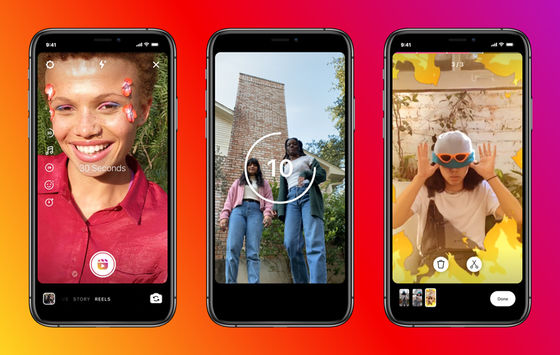The official explanation of the display criteria and ranking mechanism for Instagram posts

Instagram, an SNS that mainly posts photos and videos, is a popular platform worldwide. It's something that earns views. In order to unravel the ``why'' about such Instagram, the official explains the ``
Shedding More Light on How Instagram Works
https://about.instagram.com/blog/announcements/shedding-more-light-on-how-instagram-works
The algorithm behind Instagram is explained by the company's CEO Adam Mosseri. According to Mosseri, one of the biggest misunderstandings about Instagram's algorithm is that 'Instagram has an algorithm that monitors what users see and don't see.' Mosseri clearly denied that 'this kind of algorithm does not exist.' He continued that Instagram uses multiple algorithms, classifiers and processes, each with its own purpose, to provide personalized service to each user.
When the service started in 2010, Instagram was just a platform with photos lined up in chronological order. However, as more users began to use Instagram, it became difficult for users to check all posts, and it seems necessary to select the content to be shown to each user. In fact, until 2016, users seemed to have missed 70% of the posts in the feed , so in order to display posts that are more interesting to users in the feed, Instagram ranks posts Algorithm for ranking decided to introduce the
In addition, Instagram has three main functions: ' Feed & Stories ', ' Search & Discover ', and ' Reel '. Each one has its own algorithm,' explains Mosseri.
◆ Feed & Stories

Feed and Stories are Instagram's main features and are meant to let you see the content posted by your closest friends and family. As mentioned above, this feed & story uses a ranking algorithm, but how it works can be divided into multiple steps.
The first step in ranking is whether or not it is 'content of users following users'. Although there are some exceptions, what is basically displayed in Feed & Stories is 'the content of users who are following'.
The posts are then categorized based on user preferences. Classification is based on all sorts of information, from 'time posted' to 'whether users like photos or videos' to 'how often they like videos'. In addition, in Feed & Stories, roughly, 'information about posts (measures the popularity of posts, etc.)' → 'poster information (measures how much interest the user has)' → 'user information It seems that information is emphasized in the order of '(indicator for grasping user's preferences)' → 'user's past interaction history (measures how much interest is in the post of a specific person)'.
After ranking based on these, we select posts that are likely to cause some action such as liking or commenting by users.
We then use considerations such as avoiding posting by the same person in a row at the end to determine which posts are shown in Feed & Stories.
◆ Search & Discover

Search & Discover is designed to help you discover new things. The Search & Discovery screen displays square thumbnails of photo and video content recommended for users. Feeds and Stories show posts from people you follow, but Search & Discover shows posts from accounts you don't follow.
Algorithms in Search & Discover also rank posts first, then categorize content that users may be interested in. Specifically, the user's hobbies and preferences are examined from past 'likes' and 'saves', as well as posts that have received comments in the past. For example, the content displayed on the search & discovery screen for users who “liked” a photo of a specific restaurant surveyed “users who liked the same restaurant photo” and searched for “other users who liked the same restaurant”. It seems that it examines 'accounts' and selects posts that may be of interest from there.
If you find a 'group of photos and videos that the user is interested in' while repeating this work, sort the content similar to that group in the 'order in which the user is likely to be interested' and display the search & discovery screen. line up. ``The order in which users are likely to be interested'' is said to be inferred from ``predicting the likelihood that users will take some action on the post.''
In addition, in search & discovery, the algorithm uses 'information about posts (number of likes and comments on posts, etc.)' → 'history of interaction with poster (whether or not the poster has communicated in the past etc.)” → “User activity (information about what the user has liked or commented on in the past)” → “Poster information (information about the poster)”. So it's not in the same order as Feed & Stories emphasizes.
In addition, there are
◆Reel

'Reel' is a function that allows you to share short videos of about 15 to 30 seconds, and you can also add stamps, paints, music, AR effects, etc. to color your videos. The reels are designed to entertain the user and, similar to the Search & Discover screen, display a number of posts from accounts the user has not followed. Therefore, the reel is displaying content through a process very similar to search & discovery. However, since reels are specifically focused on 'what entertains the user', the development team collects feedback on whether users find a particular reel interesting or uninteresting, and asks smaller creators to It seems that we are classifying content that entertains users with eyes on.
Information that is emphasized in reels is 'user activity (information about which reel the user liked in the past)' → 'history of interaction with the poster (whether or not the poster has communicated with the poster in the past'). etc.)” → “Information about the reel (number of likes and comments on the reel, etc.)” → “Poster information (information on the poster of the reel)”.
In addition, low-resolution reels,

In addition, Mosseri also explains ' shadow van ' by Instagram.
Shadowbans are regulatory measures that make it harder for unwanted accounts and posts to appear in platform recommendations and search results. Regarding this, Mosseri said, ``People sometimes criticize that Instagram is shadowing. However, the word Shadowban does not correctly describe the algorithm that works widely on Instagram.'' I'm talking If you know exactly what kind of content Instagram recommends as a recommendation and what kind of content it treats as not following the guidelines, you will be able to understand why your posts are not viewed so much. Mosseri explains that it should be.
Related Posts:
in Mobile, Software, Web Service, Posted by logu_ii







